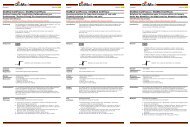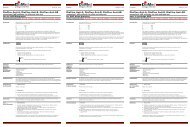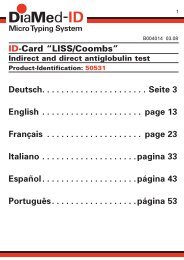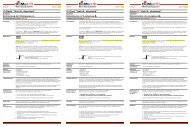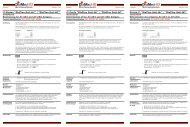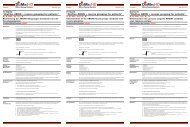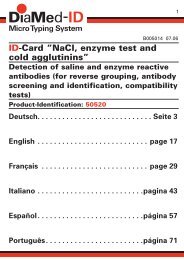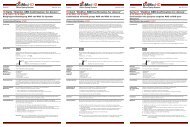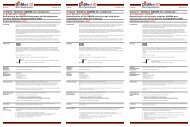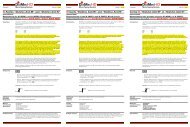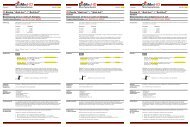Create successful ePaper yourself
Turn your PDF publications into a flip-book with our unique Google optimized e-Paper software.
13 - PERFORMANCES<br />
Sensitivity<br />
• 138 patients infected by <strong>HIV</strong> at different stages (AIDS, ARC, others) have been tested and found positives with<br />
the test <strong>GENETIC</strong> SYSTEMS <strong>HIV</strong>-1 Antigen <strong>EIA</strong>.<br />
• 20 well documented seroconversions panels were studied. The results obtained are comparable to those observed<br />
with other <strong>HIV</strong> <strong>Ag</strong> assay.<br />
• 55 cell culture supernatants of <strong>HIV</strong> 1 (53 group M and 2 group O) and the dilution panel «<strong>Ag</strong> VIH SFTS 96» have<br />
been found positives with the <strong>GENETIC</strong> SYSTEMS <strong>HIV</strong>-1 Antigen <strong>EIA</strong> test except 2 dilutions of group O cell<br />
culture supernatants.<br />
- The 53 cell culture supernatants of the <strong>HIV</strong>-1 group M are composed of the following genotypes : 10 genotypes<br />
of A, 10 of B, 9 of C, 5 of D, 11 of E, 2 of F, 2 of G, 1 of H, 2 of J, and 1 of N.<br />
- The dilution panel «<strong>Ag</strong> VIH SFTS 96» includes the following genotypes : A, B, C, D, E, F, G, H genotypes from<br />
the Group M and 1 from the group O.<br />
Analytical Sensitivity<br />
The sensitivity limit of the test has been evaluated on a range of dilutions prepared from the french national standard<br />
(purified viral lysate of genotype B diluted in negative citrated plasma) and the BBI panel (PRA 801). The sensitivity<br />
limit has been estimated at 8 pg/ml <strong>Ag</strong> <strong>HIV</strong> whatever protocol is.<br />
The calibration curve obtained with <strong>HIV</strong>-1 <strong>Ag</strong> Standard (code 72217) calibrated sample is linear between 0 and<br />
100 pg/ml<br />
Diagnostic Specificity<br />
The diagnostic specificity evaluated on :<br />
• 4038 blood donors has been estimated at 99.95%.<br />
• 209 clinical patients has been estimated at 100%.<br />
A panel of 105 patient samples has been tested. It is composed of samples :<br />
• containing antibodies to HAV, HCV, HTLV, HSV, EBV, Rubella, Toxoplasma Gondii, Treponema Pallidum, CMV<br />
• containing auto-Ab, IgG, IgM rhumatoid factor<br />
• from pregnant women, cirrhosis population, multiply transfused and patients reached of Systemic lupus erythematosus<br />
Only one sample came from and patient reached of Systemic lupus erythematosus has been found reactive with the<br />
Genetic Systems <strong>HIV</strong>-1 <strong>Ag</strong> <strong>EIA</strong> test but not confirmed with the confirmatory test.<br />
Accuracy<br />
The intra-assay reproductibility has been evaluated by testing 3 positive samples and one negative sample 30 times<br />
in the same run.<br />
The inter-assay reproductibility has been evaluated by testing testing 3 positive samples and one negative sample<br />
during 5 days with 2 different technicians.<br />
The coefficient of variation for positive samples was less than 10%.<br />
14 - LIMITS OF THE TEST<br />
• The <strong>GENETIC</strong> SYSTEMS <strong>HIV</strong>-1 Antigen <strong>EIA</strong> Procedure and the Interpretation of Results must be followed when<br />
testing serum, plasma, or cell culture specimens for the presence of <strong>HIV</strong>-1 antigen. The user of this kit is advised<br />
to read the package insert carefully prior to conducting the test. In particular, the test procedure must be carefully<br />
followed for sample and reagent pipetting, plate washing, and timing of the incubation steps.<br />
• A designation of reactive for <strong>HIV</strong>-1 antigen must not be based on a single reactive test result. Additional testing,<br />
such as confirmatory testing, is required to establish the specificity of any specimen reactive by the screening<br />
procedure.<br />
• All highly sensitive immunoassays have a potential for non-specific reactions which can lead to false positive<br />
results. The proportion of reactives that are false will depend on the sensitivity and specificity of the test kit.<br />
• Negative results can occur if the quantity of marker present in the sample is too low for the detection limits of the<br />
assay, or if the marker which is detected is not present during the stage of disease in which a sample is collected.<br />
• The varaibility of <strong>HIV</strong> virus doesn’t allow to exclude the possibility of false negative results. No known test method<br />
can offer complete assurance that the <strong>HIV</strong> virus is absent.<br />
• Failure to add specimen or reagent as instructed in the procedure could result in a falsely negative test. Repeat<br />
testing should be considered where there is clinical suspicion of infection or procedural error.<br />
• An absorbance value of less than 0.000 AU indicates a procedural or instrument error and must be repeated.<br />
• Factors that can affect the validity of results include failure to add the specimen to the well, inadequate washing<br />
of microplate wells, failure to follow stated incubation times and temperatures, addition of wrong reagents to<br />
12




